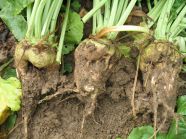
"Girth scab" of sugar beet, caused by Aphanomyces cochlioides

While sugar yield is only little affected by the scab disease itself, such secondary rots may eventually cause losses in quality and suitability for storage.
Bacteria or fungi?
In practice, there is some confusion over the true causes of the disease, as two fundamentally different pathogens are generally named as potential causing agents: Streptomyces spp. from the class Actinobacteria and the fungus Aphanomyces cochlioides. Thus, in particular in years with heavy infestation, the question rises on which pathogen is actually responsible for the damage. Today, in most beet growers’ practical guides and information sheets Actinobacteria are named as the causing agents. These pathogens are well known as causing a scab disease in potato. But while the pathogenicity of these bacterial pathogens towards potato is well studied and understood, their involvement in the similar disease of sugar beet has always been in doubt, and has only rarely been investigated. The fungus Aphanomyes is known to be involved in seedling diseases and damping off of sugar beet. Results from the US and the UK also show its involvement in scab diseases of older sugar beet. Therefore, their potential to cause the ‘girth scab’ disease has also repeatedly been discussed.
Field and laboratory studies
Studies performed at the Institute of Plant Protection have now revealed new evidence that in fact A. cochlioides is often causing sugar beet ‘girth scab’. The pathogen not only was isolated from affected beet roots in Bavaria on a regular basis, it also caused typical scab symptoms in laboratory and greenhouse tests with young beet plants. Actinobacteria of the genus Streptomyces that were also tested in these assays, in contrast, seemingly are not involved in the disease.
The genus Aphanomyces belongs to the group of fungus-like oomycetes that preferentially spread via spores swimming in soil water. These spores are therefore typically produced when soil is water-logged, a condition that also favours their spread from plant to plant. This characteristic feature of the pathogen matches well with the particularly high disease incidence in years with a wet spring/ summer season. It also underpins the significance of soil structure: compacted soils with poor drainage will promote water-logging and thus, support the development of the disease.
Direct control measures not available
Just as in other soilborne diseases such as Rhicoctonia root rot, direct control of the girth scab pathogen is not possible. Seed dressing will act against such pathogens at an early growth stage, but is not active against later attacks. Disease can only be prevented by diverse agricultural measures that maintain soil structure and promote soil aeration. Any measure that prevents water-looging conditions will contain the disease to a certain degree. Of vital importance, of course, are the prevailing weather conditions, as the fungus will only be able to attack plants at high soil moisture which is favoured by rainy weather.
Variety specific differences
Beet varieties show different degrees of susceptibility to the pathogen. This has repeatedly been shown in variety trials where disease severity and damage caused by ‘girth scab’ differed considerably between varieties. Beet growers should keep this in mind this when selecting the variety for an infested/ endangered field.





